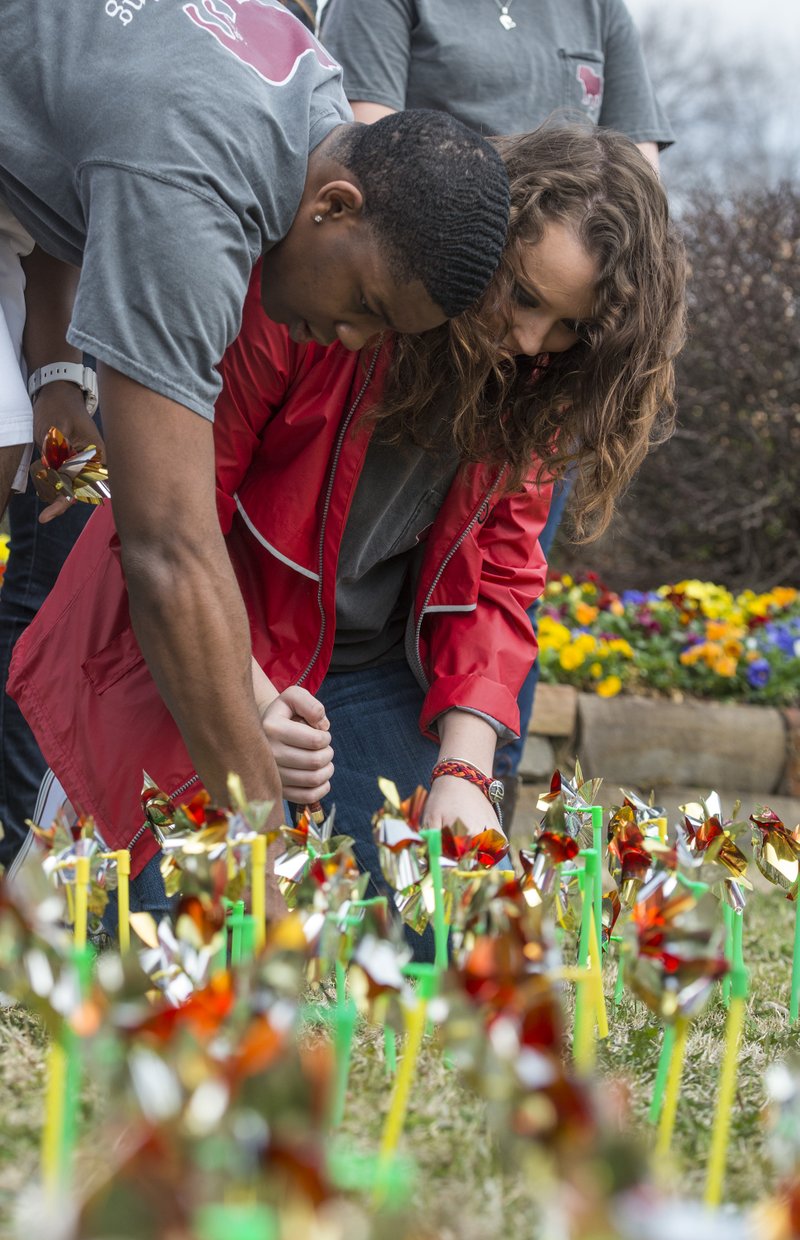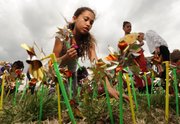"It's not stranger danger. It's not the creepy guy in the white van. It's not the stereotype," said Abra Lang Morgan, a social worker and child advocate at the Children's Safety Center in Springdale.
She spoke of the most common type of child abuse -- sexual abuse at the hands of someone the child trusts.
Fast Facts
Suspect child abuse?
Call the anonymous hotline.
Arkansas Child Abuse Hotline — (800) 482-5694
Assistance is available 24 hours a day, seven days a week.
Information: childrenssafetycent…
By the Numbers
533 — Reported abuse cases for 2013 in Washington County
1,200 — Cases seen in 2013 by children’s advocacy centers in Northwest Arkansas
42 — Cases seen in April (as of Tuesday) at the Children’s Safety Center in Springdale
“Those numbers are not sad. It’s great,” said Abra Lang Morgan, a child advocate at the children’s center. “Just because we see low numbers doesn’t mean sexual abuse has just stopped.”
1 to 3 — For every child that tells, three don’t.
1 in 4 — Girls abused
1 in 6 — Boys abused (The CSC saw more boys than girls last January.)
9 — The average age of children abused.
Source: Children’s Safety Center
Definition
Sexual Abuse
Physical contact and touching
• Touching a child’s genitals or private parts for sexual purposes.
• Making a child touch someone else’s genitals or play sexual games.
• Putting objects or body parts (like fingers, tongue or penis) inside the vagina, in the mouth or in the anus of a child for sexual purposes.
Noncontact sexual abuse
• Showing pornography to a child.
• Deliberately exposing an adult’s genitals to a child.
• Photographing a child in sexual poses.
• Encouraging a child to watch or hear sexual acts.
• In appropriately watching a child undress or use the bathroom.
Source: Stop It Now!; Children’s Safety Center
"Ninety-six percent, the majority of cases, are family members or someone the child knows," she said.
Morgan and the other staff at the children's center work to help children deal with the trauma of child abuse, from the forensic investigation to court appearances to recovery. April is National Child Abuse Prevention Month.
"Child sexual abuse is any interaction between a child and an adult (or another child) in which the child is used for sexual stimulation of the perpetrator or observer," Morgan said, reading from information from the National Child Traumatic Stress Network. "Sexual abuse can include both touching and nontouching behaviors.
"It doesn't have to be physical," she said. "It can be exposing them to live sex acts, pornography, taking pictures of genitalia. The era of just seeing up girls' skirts is gone."
Education of both parents and children about privacy and expectations on social media is vital.
"Parents really have to be aware when they give their child a phone with Internet on it," Morgan said. This is the preferential choice of pedophiles, the place they connect to child porn and "erotica." Erotica is something that seems safe -- like pictures of children in clothes -- but it provides a pedophile sexual stimulation, she explained.
"A picture of a fifth-grade cheerleader in her uniform posted on Facebook, any pedophile can use," Morgan continued.
And someone can pretend to be "whoever" on Facebook, luring youngsters with promises of love, added Emily Rappe, director of development for the children's center.
Identified
Morgan identified two types of pedophiles: situational and preferential.
The situational pedophile does not seek children; rather he offends when he has the opportunity, for example, with his girlfriend's child or stepdaughter when they live together. Preferential offenders, however, seek out children and build a trusting relationship with their victims.
"We see pedophile offenders 'groom' the children," Morgan said. "They have access to and trust of the child. They are the scout leader, the soccer coach, the teacher at church -- and that's not to say all soccer coaches and scout leaders are pedophiles. They dress well. They are stand-up members of the community.
"Most of the time these preferential abusers are targeting a certain characteristic, like age or hair color," she continued. "He spends more time with kids than adults -- now, just because a person does these things does not mean he's a pedophile.
"But there is no sign or stamp that says, 'This is a pedophile. Watch out!'"
Even family gatherings should be viewed through the eye of a protecting caregiver, Morgan said.
At the close of such events, the family often insists the child give Grandpa a hug, Morgan illustrated. "You know, you say, 'We're not going home until you give grandpa a hug.'"
"Don't make them give that hug. You can wave goodbye. Offenders want the experiences like this to build a relationship with a child," she continued.
Part of the "grooming" process might be buying toys and gifts for the child that seem unexplained to the parent. For example, a cell phone with only so many minutes, and then he gets another one, Rappe said.
Educate Now
In school, children hear about the dangers of fires and drugs. Why are they not warned about the dangers of a pedophile, Morgan asked.
Children -- and parents -- must be educated, Morgan insisted, and Rappe agreed.
"Parents, you must talk to your children NOW! Start talking to your child when he is 1 year old."
The center can provide parents with a list of age-appropriate language and lessons for all stages of development, which parents can use and still stick to their family values, Morgan said.
Parents should communicate with children why their bodies work the way they do and that the parts are not bad or shameful, Morgan added. Pedophiles often use shame to keep their victims quiet.
She also insisted parents should teach children to call their body parts by the correct names. Nicknames for body parts can be a barrier to exposure, while correct terms can make it more difficult for an offender to target a child.
"If a girl calls her vagina a 'garage,' you can bet that offender will play a game where she uses her garage to park a 'car,'" Morgan said. "An adult might not pick up the clues if a child says her uncle touched her 'cookie.'
"It's creating a comfortable environment, where parents can talk and their children can understand," she said. This environment needs to be in place before a child develops and grow with him.
"Tell children there are no secrets from parents," Rappe said. "An offender keeps sexual abuse quiet when it's based around secrets. But because of that relationship you've built, the child knows it's OK to talk to their parents about sex."
Families can use this time to identify at least one person -- inside and outside of the family -- that the child can trust and tell, Rappe added. And parents also should tell children the warning signs of abuse, and what a child can do when he sees that.
"Teach children that it's their body, and they have control of it," Morgan said. "A touch that hurts is not OK."
Physical signs of sexual abuse are rare, Rappe said. The offender doesn't want to leave a mark.
"They don't want their actions to hurt the children," Morgan said. "They want it to feel good, so they can do it over and over.
"Even if the child has a physical exam, 90 percent of the exams are normal," she said. "There is no magical, physical test. Children heal fast and, when disclosure is delayed, they have time to heal."
But signs of abuse do appear.
"They usually include a sudden or drastic change of behavior, perhaps a child becomes withdrawn or lashes out in anger," Rappe said. They have nightmares, or don't sleep, or sleep all the time. They display inappropriate language or knowledge. Older children might begin to self-injure, ignore hygiene, run away, use drugs, become promiscuous, have bouts of depression and become defiant and oppositional with outbursts at school, she continued.
Young, young children digress in development -- start wetting the bed or sucking the thumb again, Rappe listed. Or the child might resist having his clothing removed. He also might use new words or actions that he shouldn't know or understand.
"Just because a child has one or two of these, that doesn't for sure mean sexual abuse," Morgan qualified.
These also might signal another transition and change in a child's life -- divorce of his parents, death of a loved one, problems at school, Rappe explained.
Some of that it just being a teenager, Morgan admitted.
"It's what's outside of 'normal' for that child -- a child does a complete 180 with nothing going on," Rappe said.
"Trust your instincts as an adult," Morgan added.
With that open, trusting relationship between a parent and a child, problems -- even abuse -- can be addressed.
"The No. 1 healing factor is a supportive caregiver," Morgan said. "Our goal is to guide them along the path to be a survivor."
NAN Life on 04/23/2014


